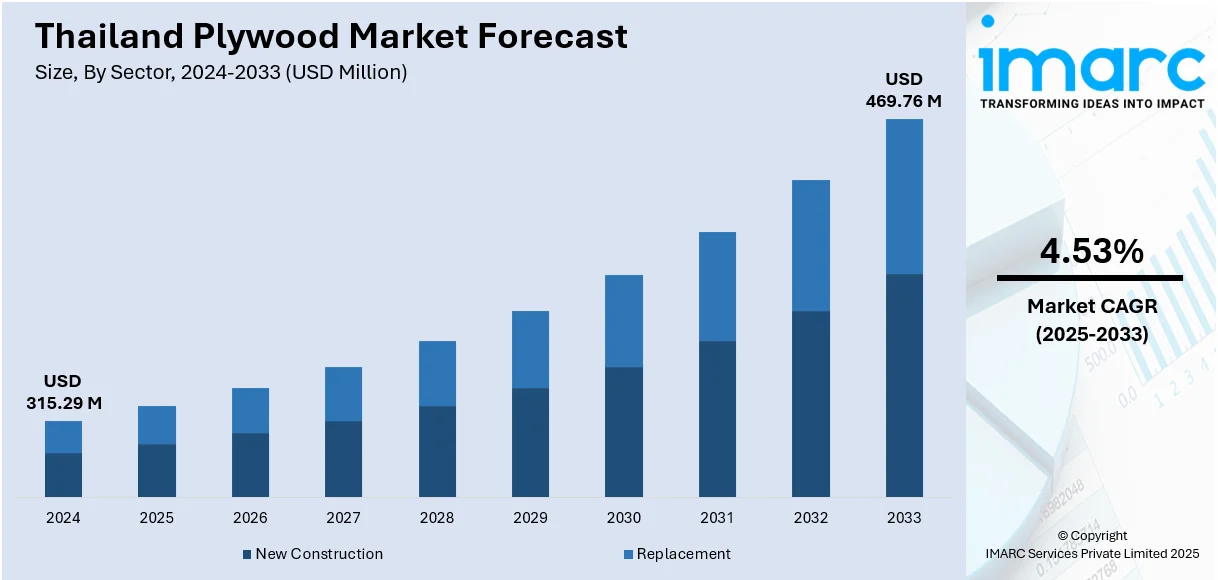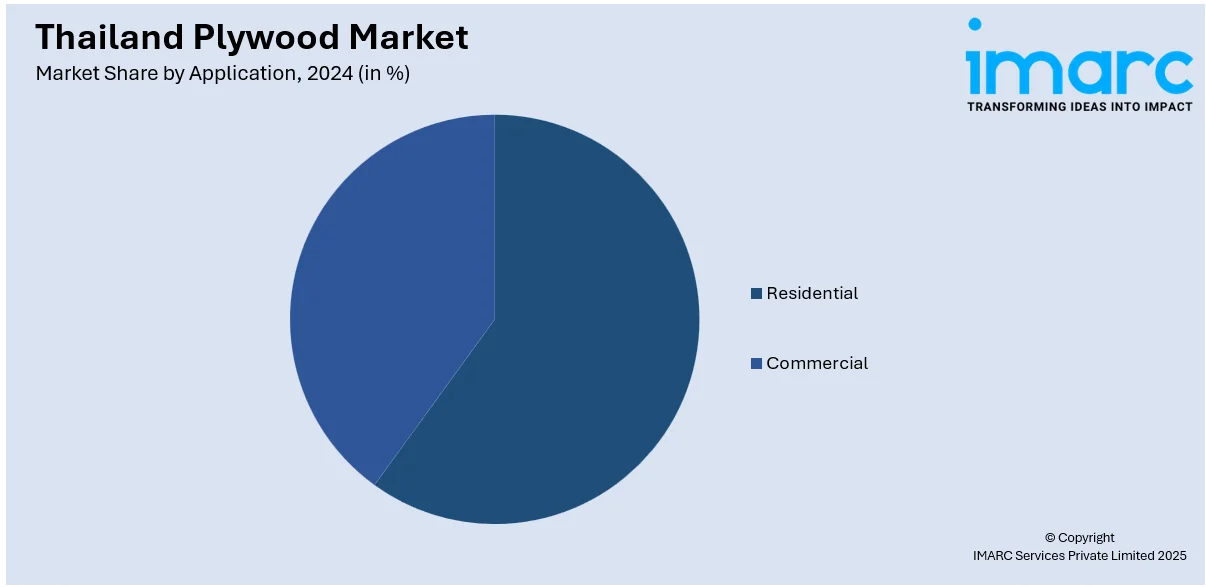
Thailand Plywood Market Size, Share, Trends and Forecast by Application, Sector, and Region, 2025-2033 2025-2033
Thailand Plywood Market Overview:
The Thailand plywood market size reached USD 315.29 Million in 2024. The market is projected to reach USD 469.76 Million by 2033, exhibiting a growth rate (CAGR) of 4.53% during 2025-2033. At present, with rapid urbanization and infrastructure growth underway, the need for affordable, durable, and adaptable construction materials is increasing. As both domestic and export furniture markets are expanding, producers continue to depend on plywood to satisfy volume and cost-effectiveness needs, which is fueling the Thailand plywood market share.
|
Report Attribute
|
Key Statistics
|
|---|---|
|
Base Year
|
2024
|
|
Forecast Years
|
2025-2033
|
|
Historical Years
|
2019-2024
|
| Market Size in 2024 | USD 315.29 Million |
| Market Forecast in 2033 | USD 469.76 Million |
| Market Growth Rate 2025-2033 | 4.53% |
Thailand Plywood Market Trends:
Rising construction activities
Increasing construction activities are fueling the market growth. As the country is experiencing rapid urbanization and infrastructure expansion, the demand for cost-effective, strong, and flexible building materials is rising. Plywood is widely used in various construction applications, such as flooring, wall panels, partitions, roofing, and formwork. Its durability, resistance to moisture and bending, and ease of handling make it a preferred material among builders and contractors. Residential housing development, broadening of commercial complexes, renovation of old buildings, and ongoing public infrastructure projects like roads, airports, and railways are contributing to increased plywood utilization. Architects are opting for plywood because it reduces construction time and supports modern architectural designs. Moreover, plywood is employed in temporary structures and concrete shuttering, which are essential in fast-paced projects. The rising popularity of green and modular construction techniques is also catalyzing the demand for engineered wood products, such as plywood. With the growing investments in construction, both in urban and semi-urban areas, the need for reliable and affordable wood-based materials remains high. As per industry reports, the Thailand construction market size is anticipated at USD 28.01 Billion in 2025.

To get more information on this market, Request Sample
Growth of furniture manufacturing
The growth in furniture manufacturing is positively influencing the market in Thailand. Plywood is widely used in producing cabinets, tables, chairs, beds, and modular furniture due to its strength, lightweight nature, and smooth finish. As both domestic and export furniture markets are expanding, manufacturers continue to rely on plywood to meet volume and cost-efficiency requirements. Thailand's skilled labor, design innovation, and rising demand for customized furniture are further boosting production. Plywood’s compatibility with laminates and veneers also makes it ideal for stylish and durable furniture. Additionally, the shift towards ready-to-assemble and space-saving furniture is enhancing plywood usage. As urban lifestyles are evolving and people are seeking functional and affordable furniture, the furniture manufacturing sector continues to fuel steady growth of the market across Thailand. Industry reports indicated that the furniture market size in Thailand is set to reach USD 2.41 Billion in 2033.
Broadening of e-commerce portals
The expansion of e-commerce portals is stimulating the Thailand plywood market growth. Online platforms make it easier for people to access a wide range of plywood-based furniture and do-it-yourself (DIY) products, encouraging more purchases. Small furniture businesses and carpenters are using e-commerce to reach broader markets, driving the demand for plywood as a key raw material. Additionally, plywood is widely utilized in the production of sturdy and reusable packaging for shipping goods, especially for electronics, appliances, and heavy items. With the growing popularity of online shopping, packaging needs are rising, directly supporting plywood adoption. E-commerce expansion is also boosting the renovation and interior décor segment, as more people are seeking affordable ways to upgrade their homes. According to the IMARC Group, the Thailand e-commerce market is set to attain USD 1,156.38 Billion by 2033, exhibiting a growth rate (CAGR) of 26.85% during 2025-2033.
Thailand Plywood Market Segmentation:
IMARC Group provides an analysis of the key trends in each segment of the market, along with forecasts at the country and regional levels for 2025-2033. Our report has categorized the market based on application and sector.
Application Insights:

- Residential
- Commercial
The report has provided a detailed breakup and analysis of the market based on the application. This includes residential and commercial.
Sector Insights:
- New Construction
- Replacement
A detailed breakup and analysis of the market based on the sector have also been provided in the report. This includes new construction and replacement.
Regional Insights:
- Bangkok
- Eastern
- Northeastern
- Southern
- Northern
- Others
The report has also provided a comprehensive analysis of all the major regional markets, which include Bangkok, Eastern, Northeastern, Southern, Northern, and others.
Competitive Landscape:
The market research report has also provided a comprehensive analysis of the competitive landscape. Competitive analysis such as market structure, key player positioning, top winning strategies, competitive dashboard, and company evaluation quadrant has been covered in the report. Also, detailed profiles of all major companies have been provided.
Thailand Plywood Market Report Coverage:
| Report Features | Details |
|---|---|
| Base Year of the Analysis | 2024 |
| Historical Period | 2019-2024 |
| Forecast Period | 2025-2033 |
| Units | Million USD |
| Scope of the Report |
Exploration of Historical Trends and Market Outlook, Industry Catalysts and Challenges, Segment-Wise Historical and Future Market Assessment:
|
| Applications Covered | Residential, Commercial |
| Sectors Covered | New Construction, Replacement |
| Regions Covered | Bangkok, Eastern, Northeastern, Southern, Northern, Others |
| Customization Scope | 10% Free Customization |
| Post-Sale Analyst Support | 10-12 Weeks |
| Delivery Format | PDF and Excel through Email (We can also provide the editable version of the report in PPT/Word format on special request) |
Key Questions Answered in This Report:
- How has the Thailand plywood market performed so far and how will it perform in the coming years?
- What is the breakup of the Thailand plywood market on the basis of application?
- What is the breakup of the Thailand plywood market on the basis of sector?
- What is the breakup of the Thailand plywood market on the basis of region?
- What are the various stages in the value chain of the Thailand plywood market?
- What are the key driving factors and challenges in the Thailand plywood market?
- What is the structure of the Thailand plywood market and who are the key players?
- What is the degree of competition in the Thailand plywood market?
Key Benefits for Stakeholders:
- IMARC’s industry report offers a comprehensive quantitative analysis of various market segments, historical and current market trends, market forecasts, and dynamics of the Thailand plywood market from 2019-2033.
- The research report provides the latest information on the market drivers, challenges, and opportunities in the Thailand plywood market.
- Porter's five forces analysis assist stakeholders in assessing the impact of new entrants, competitive rivalry, supplier power, buyer power, and the threat of substitution. It helps stakeholders to analyze the level of competition within the Thailand plywood industry and its attractiveness.
- Competitive landscape allows stakeholders to understand their competitive environment and provides an insight into the current positions of key players in the market.
Need more help?
- Speak to our experienced analysts for insights on the current market scenarios.
- Include additional segments and countries to customize the report as per your requirement.
- Gain an unparalleled competitive advantage in your domain by understanding how to utilize the report and positively impacting your operations and revenue.
- For further assistance, please connect with our analysts.
 Request Customization
Request Customization
 Speak to an Analyst
Speak to an Analyst
 Request Brochure
Request Brochure
 Inquire Before Buying
Inquire Before Buying




.webp)




.webp)












